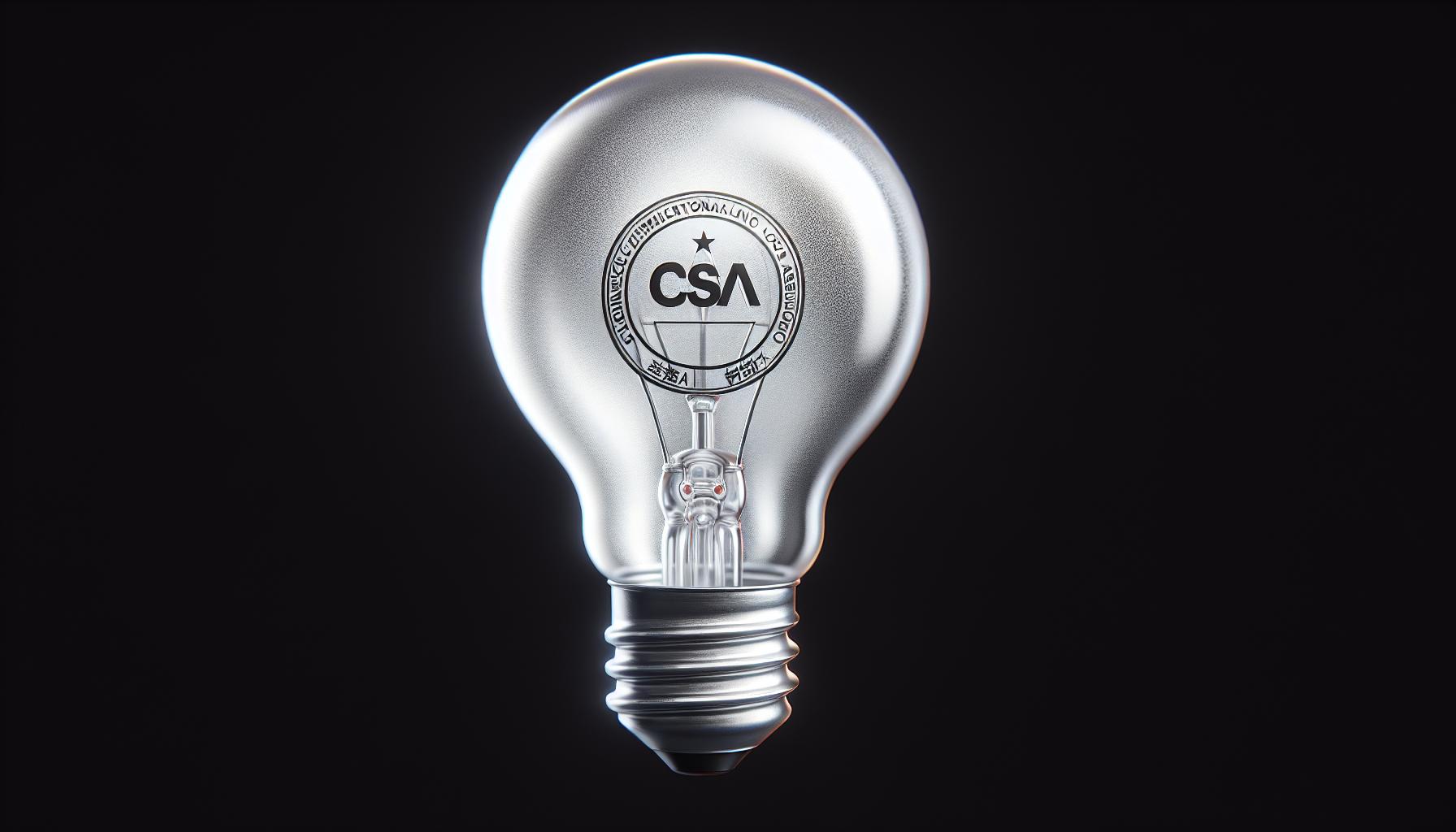Ever wondered if those new light bulbs you’re eyeing up need to have that CSA stamp of approval? You’re not alone. Safety’s a big deal, and when it comes to lighting up your home, you want to make sure you’ve got the right stuff.
Navigating the sea of certifications can be a headache, but don’t sweat it. Let’s break down what CSA approval really means for your light bulbs and why it might just matter more than you think.
What is CSA approval?
When you’re sprucing up your home with various DIY projects, light selection is crucial. You want the perfect ambiance but safety should always be your top priority. Here’s where CSA approval comes into play. CSA stands for Canadian Standards Association, an organization that’s dedicated to ensuring products meet rigorous standards for safety and performance.
CSA approval means a light bulb has undergone scrutiny and passed tests that assess its safety. This certification isn’t just for show—it’s a seal of reliability and quality that you can trust. When you see the CSA mark on a light bulb, know that it has met specific standards that are recognized not just in Canada but also across North America.
- Electrical Safety: Light bulbs are electrical devices, and any mishaps can lead to serious consequences. CSA-approved bulbs are tested for electrical safety, which reduces the risk of electrical fires or shocks.
- Material Quality: The materials used in CSA-certified light bulbs are evaluated to ensure they can withstand usage without degrading, possibly causing hazards.
- Performance Standards: These bulbs aren’t just about being safe; they’re also about performing well. They’re tested to emit the level of brightness and color they claim and to last as long as the packaging states.
Considering all these factors, CSA approval isn’t just another sticker on the package—it’s your peace of mind. Lighting is a significant part of home aesthetics and function, and you want to get it right. Certified bulbs mean you’re adding beauty without compromising on safety and quality. As a DIY enthusiast, knowing that you’re installing light bulbs that meet these high standards lets you light up your space with confidence. Remember, every time you choose a CSA-approved light bulb you’re making an informed decision—you’re choosing a product that’s safe, durable, and reliable for your masterpiece of a home.
Why is CSA approval important for light bulbs?
When you’re knee-deep in a home DIY project, selecting the right light bulbs can be as critical as choosing the perfect shade of paint. CSA approval is vital because it’s the stamp of approval from the Canadian Standards Association, which sets the bar for safety and quality across North America.
Imagine the peace of mind you get knowing that the lights brightening your newly renovated kitchen or accenting your living room have been tested for everything from electrical safety to their ability to last. That’s what CSA approval offers. It’s not just another regulatory hoop to jump through; it’s a comprehensive testing and certification process that verifies:
- Electrical Safety: The last thing you want is a fire due to faulty wiring in a light bulb. CSA-approved bulbs meet the strictest electrical standards to keep your home safe.
- Material Quality: From the glass used in the bulb to the metals in the base, CSA checks to ensure that only the best materials go into each bulb, meaning they’re less likely to crack or corrode.
- Performance Standards: Don’t you hate it when a bulb burns out faster than claimed? CSA approval means that when a light bulb says it’ll last 10,000 hours, it’s more than just a hopeful estimate.
This certification is your guarantee that you won’t have to deal with the hassle of frequent replacements or the dangers of poor-quality build. Plus, for those who’re enthusiastic about eco-friendly living, CSA-approved bulbs often adhere to energy efficiency standards, ensuring your carbon footprint is as small as it can be.
Remember, every project you dive into injects a bit of your personality into your space. Make sure you’re not cutting corners when it comes to lighting. Whether you’re installing a dimmable LED for mood lighting or bright fluorescent tubes for your workshop, you deserve the reliability and security that CSA-approved light bulbs provide.
Understanding the safety standards for light bulbs
When you’re tackling a home DIY lighting project, knowing about safety standards is as crucial as finding the perfect spot for that new chandelier. Safety standards for light bulbs act as a playbook—ensuring every product you use meets fundamental requirements to protect you and your home.
CSA approval stands out in these safety protocols. It’s a rigorous process that tests light bulbs to make sure they’re up to snuff. Think of it as a trusty compass that guides manufacturers toward producing safer and more reliable products. Here’s what they’re checking for:
- Electrical Safety: Are the light bulbs designed to prevent electric shocks, overheating, and fires?
- Material Quality: Do the materials used resist deterioration and can they stand the test of time?
- Performance Standards: Will the bulbs provide consistent light output and live up to their promised lifespan?
These aren’t mere formalities; they’re the backbone of a safe lighting setup. It’s no wonder savvy DIYers like you pay attention to these badges of honor.
« What is Light Bulb Temperature: Unlock the Secret to Perfect Room Ambiance
How Big is a Standard Light Bulb? Find Your Perfect Light Size »
Additionally, light bulbs that have earned their CSA certification are more likely to be in line with energy efficiency standards. This means not only are you ensuring a safer home, but you’re also opting for an option that’s kinder to your wallet and the planet over time.
Remember, while the CSA mark might not catch your eye as quickly as a trendy filament design, it’s a silent guard against the risks associated with subpar lighting solutions. It’s a pivotal checkpoint that no light bulb should skip if it wants to illuminate your abode. So next time you’re browsing the aisles, take a moment to ensure that certification mark is there, shining bright like a badge of assurance on your light bulb purchase.
The risks of using non-CSA approved light bulbs
You pride yourself on savvy home DIY projects, but when it comes to electrical components like light bulbs, cutting corners can lead to significant risks. Using non-CSA approved light bulbs might not only dim the brightness of your beloved home projects but also pose serious hazards.
Electrical safety is paramount, and non-CSA approved bulbs may not meet stringent safety measures. Faulty wiring or inadequate insulation within these bulbs can lead to short circuits. In the worst-case scenario, it could set the stage for an electrical fire. Moreover, materials of subpar quality could melt or degrade, posing a risk not only to your lighting fixtures but potentially to your entire home.
Interestingly, performance issues are common amongst non-CSA approved bulbs. Without adherence to performance standards, these bulbs can have a shorter lifespan, leading to frequent replacements and higher costs over time. Not only is this frustrating, but it’s also inefficient both for your wallet and the environment.
Energy efficiency is another facet where non-CSA approved bulbs lag behind. They may consume more power for the same level of illumination, contributing to higher electricity bills. The lack of energy efficiency in non-approved bulbs means you’re not contributing to energy conservation efforts – something that’s increasingly important in our energy-conscious world.
Let’s not forget that the ambiance of a room hinges on the quality of light. Non-CSA approved bulbs often deliver poor light quality, which can skew the colors and tones in a room, upsetting the visual aesthetics you’ve worked so hard to achieve.
Although it might be tempting to grab any light bulb off the shelf, remember that the risks associated with non-CSA approved bulbs outweigh the initial convenience or savings. When you’re winding down from your latest DIY endeavor, you’ll want the peace of mind that comes with knowing you’ve made smart, safe, and efficient choices for your lighting needs.
Making informed choices for your home lighting
When it comes to illuminating your home, the choices you make are crucial. Not only do they affect your home’s ambience and energy consumption, but they also have a significant impact on safety and efficiency. As a DIY enthusiast and lighting expert, you know that every detail, from the color temperature to the lumens, shapes the feel and functionality of your space.
CSA approval symbolizes a standard of safety and quality that you should not compromise on. Before you get swayed by the seemingly good deals of non-CSA approved light bulbs, consider the broader spectrum of implications these choices may have on your home.
Light quality isn’t just about brightness; it dictates the mood and can even influence your well-being. Non-CSA approved bulbs often produce a dimmer glow that could leave your vibrant wall colors looking washed out or create an unintentional melancholy setting. Remember that while good lighting should enhance your décor, it should also be conducive to your daily activities whether it’s reading, cooking or highlighting artwork.
In terms of functionality, you’re looking at a product that’s been rigorously tested for performance. CSA approved bulbs are synonymous with longevity and reliability. They’re less likely to flicker, fail prematurely, or become a fire hazard due to electrical malfunctions. Plus, when they do eventually reach the end of their life, you’ve enjoyed a consistent output that holds value for money and peace of mind.
- Here are key points to remember about CSA-approved bulbs:
Beyond the bulb, it’s essential to look into the luminaire itself. Does it have proper ventilation? Is it designed for the type of bulb you’re planning to use? Failing to match the light bulb with the appropriate fixture can lead to overheating and even damage to your housing.
By focusing on CSA-approved lighting options, you ensure that you’re investing in safety, performance, and energy efficiency. This choice supports your green initiatives while keeping your home bright and secure.
Choose wisely, for the illuminating choices you make today will shine on your home’s future.
Conclusion
You’ve got the rundown on why choosing CSA-approved light bulbs is a smart move. It’s not just about the immediate perks like safety and quality; it’s also about the long-term benefits of energy efficiency and contributing to sustainability. Remember, the right bulb ensures your space shines bright while keeping hazards at bay. So next time you’re in the aisle pondering over lighting options, go for the CSA-approved ones. They’re your best bet for a well-lit and safe home.
Frequently Asked Questions
What does CSA approval signify for a light bulb?
CSA approval indicates that a light bulb meets established safety, quality, and efficiency standards. It assures that the product has been tested for electrical hazards, adheres to material quality specifications, guarantees performance, and contributes to energy efficiency.
Is it important to use CSA approved bulbs?
Yes, using CSA approved bulbs is crucial for ensuring that your home lighting is safe, performs well, and is energy-efficient. These bulbs have undergone rigorous testing and meet strict safety guidelines, reducing the risk of electrical incidents.
Why might non-CSA approved bulbs affect my well-being?
Non-CSA approved bulbs may not be designed with the same quality and performance standards, which can impact the lighting ambiance, potentially strain your eyes, or pose electrical safety concerns, all of which can affect your overall well-being.
Can using the wrong light bulb cause overheating?
Yes, using a light bulb that is not matched properly to the appropriate fixture can indeed cause overheating. This mismatch risks damage to the fixture and can be a potential fire hazard.
How do CSA approved bulbs support sustainable energy conservation?
CSA approved bulbs are energy-efficient, meaning they use less electricity compared to non-approved options, leading to lower energy consumption. This supports sustainable energy conservation by reducing the overall carbon footprint associated with lighting.





